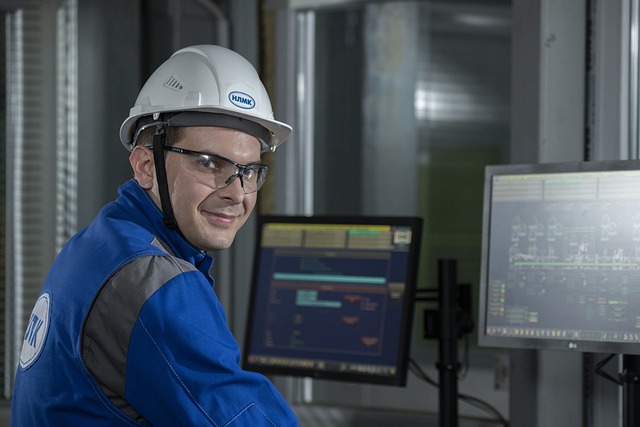Industrial web design goes beyond aesthetics it shapes how manufacturers connect with clients online. Tailored solutions balance complex product details, seamless navigation, and strong brand identity to turn websites into powerful 24/7 sales tools. Discover how leading industrial sites blend creativity and functionality to engage visitors and drive conversions in this specialized digital arena.
Fulfillment of User Search Intent and Content Expectations in Industrial Web Design
Creating an effective online presence for the industrial sector hinges on aligning website design closely with the needs of visitors. Top-tier industrial web design strategies revolve around delivering detailed case studies, portfolio showcases, and design inspiration that resonate with user search intent. These elements serve as tangible demonstrations of expertise and innovation, which are highly valued by prospective clients seeking industry-specific solutions.
Also to read : How can UK marketers leverage edge computing for real-time insights?
Industrial websites today function as 24/7 sales tools. They actively attract, engage, and convert visitors into customers by integrating features like comprehensive product catalogs, interactive visual elements, and clear call-to-actions. For instance, manufacturers showcasing product configurators or downloadable datasheets enhance user interactions, driving decision-making right from the first visit.
Delivering original, research-backed content is fundamental in meeting user expectations. Visitors look for technical specifications, visual appeal, and a seamless user experience. This entails thoughtful content structuring, impactful imagery, and intuitive navigation pathways. When websites incorporate industry-specific web features such as responsive design for mobile accessibility, fast load times, and SEO techniques tailored for industrial content they can better meet and exceed visitor anticipations.
In the same genre : How Can UK Businesses Leverage Computing for Marketing Innovation?
Sources of inspiration, like top industrial websites, exemplify how distinctive branding and purposeful design elevate engagement. These platforms embed unique branded elements that resonate with industry values, utilizing genuine product photography and social proof to build trust. Such approaches act as powerful tools for converting interest into actionable leads.
This focus on aligning content quality with user behavior underpins successful industrial web design efforts. By prioritizing clarity, differentiation, and purpose-driven navigation, industrial companies can create compelling digital experiences that foster trust and facilitate growth.
Key Characteristics of Effective Industrial Website Design
Clear Messaging and Differentiation
Precision and recall guide the foundation of industrial website design strategies: the most successful sites place concise messaging and brand differentiation at the core, ensuring users instantly recognize value. This means communicating offerings directly using prominent headlines, straightforward language, and visual cues so industrial buyers can understand services or products within seconds. Creative branding elements, from unique layouts to industry-themed iconography, further distinguish brands. Storytelling, illustrated through project timelines or interactive company histories, deepens engagement and transforms basic web structure into memorable journeys. Across manufacturing website design best practices, these approaches drive user retention and foster trust.
User Experience and Intuitive Navigation
Industrial sector web development tips stress the necessity of user experience and intuitive navigation tailored for technical audiences. Effective sites employ streamlined menus and hierarchical layouts, minimizing confusion and connecting buyers to information efficiently. Essential features include easy access to product catalogs and technical specs—often enhanced by dynamic filtering and well-labeled categories. Prominent contact options such as quote forms or dealer locators show respect for varied buying processes. Top industrial design website examples highlight clear call-to-action buttons throughout, shortening the buyer’s journey and improving lead conversion.
Visual Content and Brand Creativity
Visual storytelling stands as a pillar in industrial web design features, with real product photography, custom illustrations, and videos giving a tangible sense of scale, quality, and use cases. Application imagery not only showcases expertise but resonates with the sector’s demand for reliable, authentic presentation. Consistency in brand creativity like integrating industrial style aesthetics for websites through color, type, and graphic cues ensures each page builds a coherent identity. Many industry-specific web design features pair carefully structured product information with engaging visuals, providing depth for technical buyers while remaining accessible for wider audiences.
Industrial website design strategies draw on these elements to build trust, accelerate decision-making, and set leading manufacturers apart. Each facet clear communication, purposeful navigation, and creative application forms the benchmark for the best industrial B2B websites in today’s competitive environment.
Practical Design Features and Functional Elements
Responsive and Mobile Optimization
Industrial web functionalities demand responsive design as a baseline. Manufacturing website design best practices rely on seamless adaptation across all device sizes. This not only improves the user experience in industrial websites but also meets the expectations of industrial sector clients who need on-the-go access.
For practical responsive design for manufacturing sites, start with fluid grid layouts and scalable industrial website templates. Mobile optimization for industrial web pages should utilize streamlined navigation, finger-friendly buttons, and thumb-accessible call-to-actions. Essential features such as sticky contact forms, click-to-call functionality, swipe galleries, and collapsible menus simplify user journeys. Prioritizing adaptive imagery and quick content loads further supports diverse buyer needs, reflecting leading industrial B2B website design tips.
Technical and Security Considerations
Fast load times and robust security are indispensable in industrial web functionalities. Website speed optimization for manufacturers should include image compression, lazy loading, and efficient code structures. Regular performance audits help reveal bottlenecks that impede the industrial website’s effectiveness.
For manufacturing businesses, industrial web design security considerations are high priority. SSL certificates and HTTPS encryption should be implemented universally. Periodic site backups protect against data loss, while clear compliance with web compliance standards in the industrial sector reassures risk-averse buyers. Ensuring ADA compliance for industrial business websites fosters inclusivity and demonstrates professionalism, fulfilling core industrial website maintenance tips.
Interactive and Engagement Tools
Today’s best industrial website design strategies integrate interactive engagement tools tailored to technical decision-makers. Integrating product configurators lets users customize solutions, balancing complex industry-specific web design features with ease. Automated chatbots for industrial customer service streamline communication outside standard business hours, backed by clear industrial web functionalities for instant support.
Downloadable datasheets, case study widgets, and detailed inquiry forms facilitate online lead generation for industrial clients. Visual tools like 3D modeling and hosting virtual tours of manufacturing facilities provide immersive ways to demonstrate capabilities. Incorporating these dynamic elements, along with focused industrial homepage design ideas and graphics and imagery in industrial sites, elevates both credibility and conversion rates, aligning with best manufacturing website design practices for 2025.
Content, SEO, and Marketing Strategies for Industrial Websites
Effective Content Structure and Technical Specifications
Success in industrial website design strategies starts by emphasizing industry-relevant keywords and clear technical details on every key page. Accurate product descriptions are essential, helping buyers and engineers trust your information. For manufacturing website design best practices, structure content to showcase not just capabilities, but real certifications and sustainability commitments. This meets technical buyer expectations and highlights credibility—crucial for factory websites and industrial homepage design ideas alike.
Consider including sections for case studies and client testimonials, but always prioritize actual certifications and data sheets. Integrating product catalogs and downloadable technical specs further supports buyers in research. Balancing graphics and imagery in industrial sites with functional details ensures both engineers and procurement teams find what they need quickly.
Search Engine Optimization and Lead Capture
Implementing robust SEO techniques for industrial web content ensures visibility in competitive B2B searches. Use industry-specific web design features, such as optimized meta descriptions, schema markup, and image alt text, to enable wider organic traffic reach. Responsive design for manufacturing sites and mobile optimization for industrial web pages are now non-negotiable, with search engines prioritizing mobile-first performance.
For online lead generation for industrial clients, embed clear calls-to-action and contact forms at strategic points. Downloadable brochures or quote request forms encourage engagement. These call-to-action strategies for industrial sites should be quick to complete, respecting the technical audience’s time. Factoring in FAQs and direct support options within industrial sector web development tips can further smooth the user’s journey.
Integrating Marketing and Analytics
Modern industrial web design requires blending content marketing for industrial websites with actionable web analytics and automation. Use analytics tracking for industrial websites to identify top-performing product pages, workflow visualization needs, and sources of leads. Monitor conversion rate optimization in the industrial sector, refining page layout based on performance data.
Support marketing initiatives by integrating CRM and marketing automation tools, streamlining the follow-up process for qualified buyers. This nurtures prospects over long B2B sales cycles and aligns with digital transformation in industrial marketing, enabling teams to adapt and tailor communications. Strategic use of case studies of industrial design web projects, alongside product transparency and trust signals, helps guide users from initial interest to enquiry—defining characteristics of industrial-oriented websites committed to measurable results.
Examples of Leading Industrial Web Designs
Innovative and Creative Project Showcases
Top industrial site examples like CHI C.H.I Overhead Door and Marley spotlight how customized visuals and advanced configurator tools set new standards for manufacturing website design best practices. These case studies demonstrate industrial website design strategies that move beyond templates by integrating tailored product sections, helping both residential and commercial customers quickly locate essential information. For instance, CHI C.H.I Overhead Door’s configurator enables seamless exploration and specification of custom garage doors, streamlining the user experience and generating qualified leads—key for industrial B2B website design tips.
Sites such as Marley deploy striking 3D graphics and mega menus, proving that industrial homepage design ideas can be both visually impressive and highly navigable. Hajster, meanwhile, stands out for transforming industry-standard interfaces through conceptual design and subtle animation, offering clear branding through industrial web design while enhancing the user experience in industrial websites.
High-Impact Visual Storytelling
High-quality imagery and engaging video are pivotal industry-specific web design features, with websites like Velux using video tours to vividly depict product applications in real-life settings. This approach aligns with current web design trends in the industrial sector, making complex solutions accessible at first glance.
Packwire’s bold, animated layouts and Energy Park’s sustainability-focused hero videos highlight that manufacturing website design best practices now revolve around visual storytelling. Such strategies create instant connections and clarify value propositions, which is fundamental for effective online lead generation for industrial clients. Embedding trust-building elements, such as client logos and company milestones, in prominent locations is a defining characteristic of industrial-oriented websites and supports conversion rate optimization in the industrial sector.
Balancing Functionality with Aesthetics
Balancing visual appeal with usability remains critical for responsive design for manufacturing sites. Industrial website navigation best practices like search bars, multilingual support, and quick contact forms simplify site use for global and domestic visitors alike.
Examples such as Amazon Filters and VJTechnologies showcase how effective functional design elements for factory websites from progressive navigation strategies to integrated chatbots meet the needs of industrial buyers and accelerate their decision-making processes. Integrating product catalogs in industrial web design and leveraging real product photography further ensure product transparency, while accessible data sheets address the importance of technical specifications on industry sites.
Collectively, the best industrial website examples combine user experience optimization, strategic content structure for manufacturing websites, and specialized features to create high-performing, conversion-focused industrial web platforms. This blend of inspiration and practical design solidifies a manufacturer’s digital presence and drives engagement in a competitive industry.
How Specialized Agencies Support Industrial Web Development
Agency Expertise and Sector Knowledge
Industrial web development agencies bring a depth of industry understanding, focusing on the needs of engineering, plastic, and electronics manufacturers. A UK-based team supporting the UK manufacturing sector will typically combine experience with up-to-date knowledge of industrial website design strategies and sector web development tips. Rather than using generic methods, these agencies analyze the unique workflow, terminology, and decision-making journeys of industrial clients. Their expertise ensures solutions that reflect industry-specific features from intuitive navigation to integration of product catalogues helping businesses accomplish their online lead generation and brand differentiation goals.
Typical Project Timeline and Process
Project workflows are structured to encourage collaboration with manufacturers at every step, building confidence and clarity. Most custom website design projects for industrial clients span 12-16 weeks, a timeline that encompasses planning, wireframing for industrial web design, user journey mapping, prototyping interfaces, and then moving to development, testing, and deployment. Each phase is marked by regular communication: agencies tend to provide in-house project managers who facilitate feedback sessions, ensuring content, functional design elements, and industrial homepage design ideas fully capture technical requirements and buyer intent. Activities like user testing for industrial website effectiveness and troubleshooting common industrial web design issues are built into these processes, maximizing both usability and impact.
Technologies and Platform Choices
WordPress CMS is a preferred platform for industrial web development agencies due to its flexibility, user-friendly back-end, and scalability a feature critical for the UK manufacturing sector where ongoing updates to technical specifications, digital brochures, and e-commerce solutions for industrial products are common. Top agencies often couple their WordPress builds with bespoke plugins, supporting features like integrating product catalogs, advanced analytics tracking, and security considerations tailored for factory websites. In addition to design and build, agencies provide a suite of ongoing services, including SEO techniques for industrial web content, content marketing for industrial websites, social media management, and maintaining ADA compliance for industrial business websites.
Case Study: The Shearline Group
A standout example of custom website design is the Shearline Group project. Here, the agency developed dedicated websites for three manufacturing subsidiaries CNC machining, metal fabrication, and laser cutting each benefiting from industry-specific features and optimized content structure for manufacturing websites. Alongside, a unified group portal was launched to showcase the scope and synergy of the Shearline brand, reinforcing their capabilities across sectors. This multi-site strategy demonstrates how industrial web development agencies can create not only impactful standalone sites but also interconnected digital ecosystems tailored for the UK manufacturing sector. By unifying brand identity and providing clear, purpose-built user experience design, such projects elevate both online visibility and conversion effectiveness.










